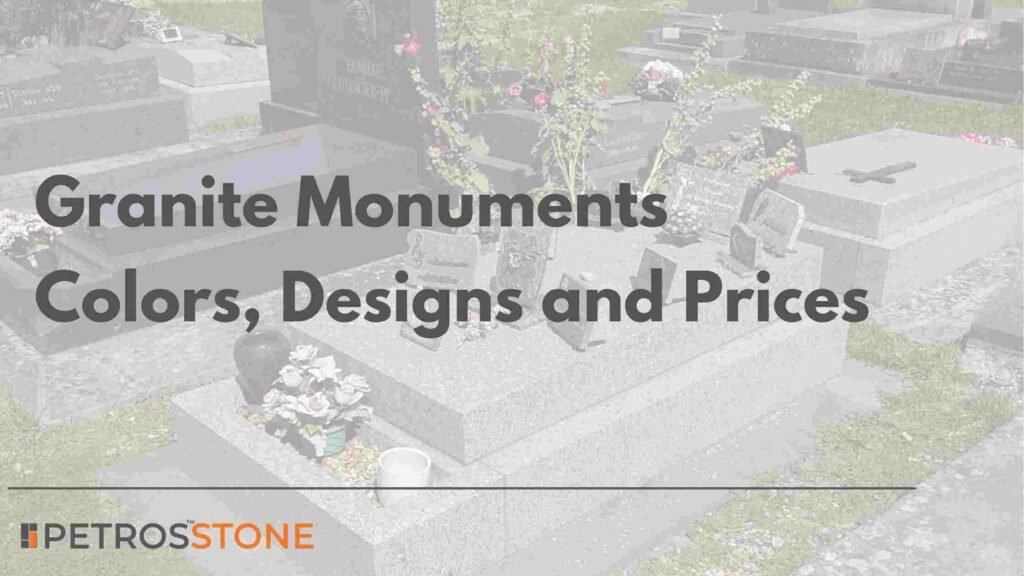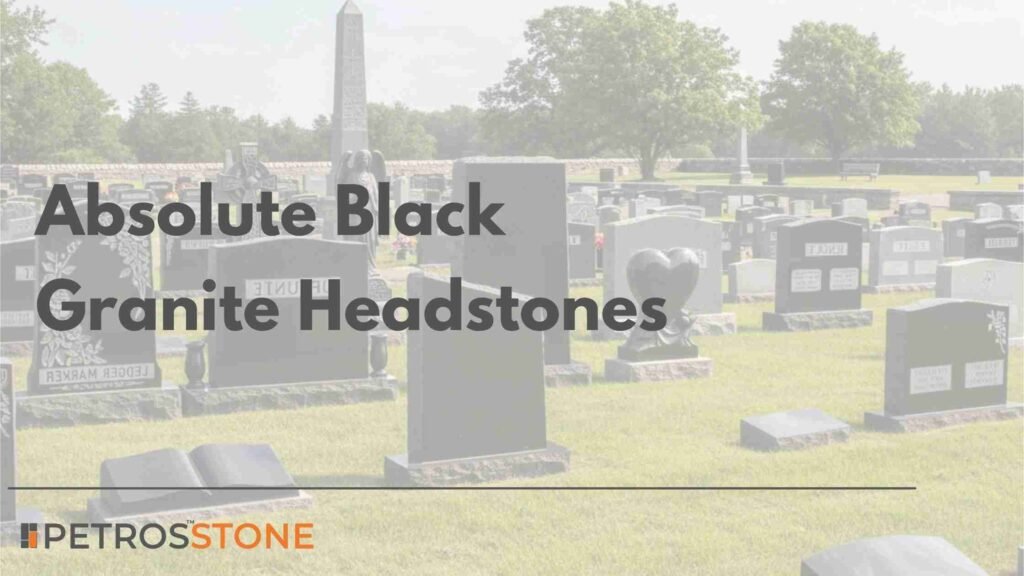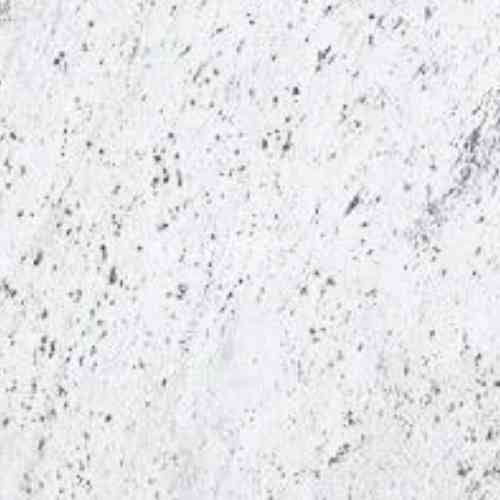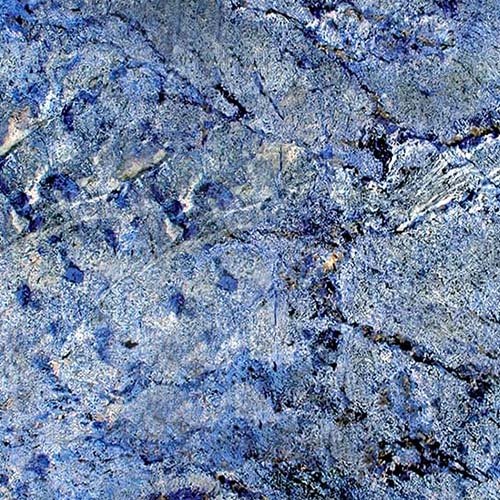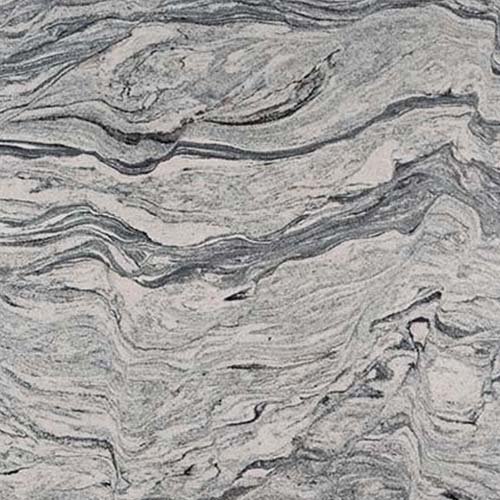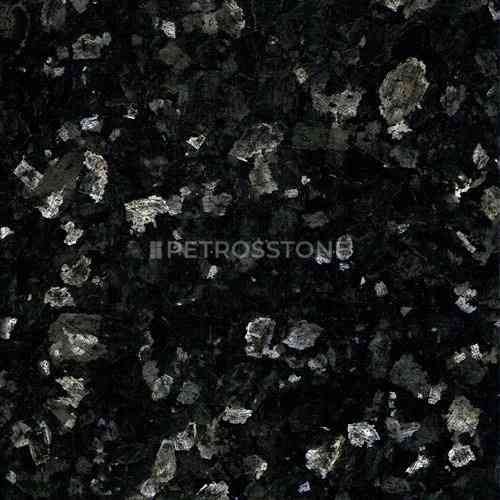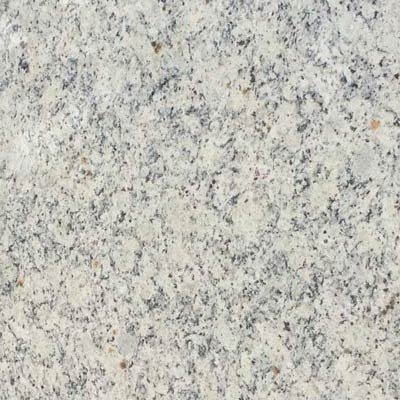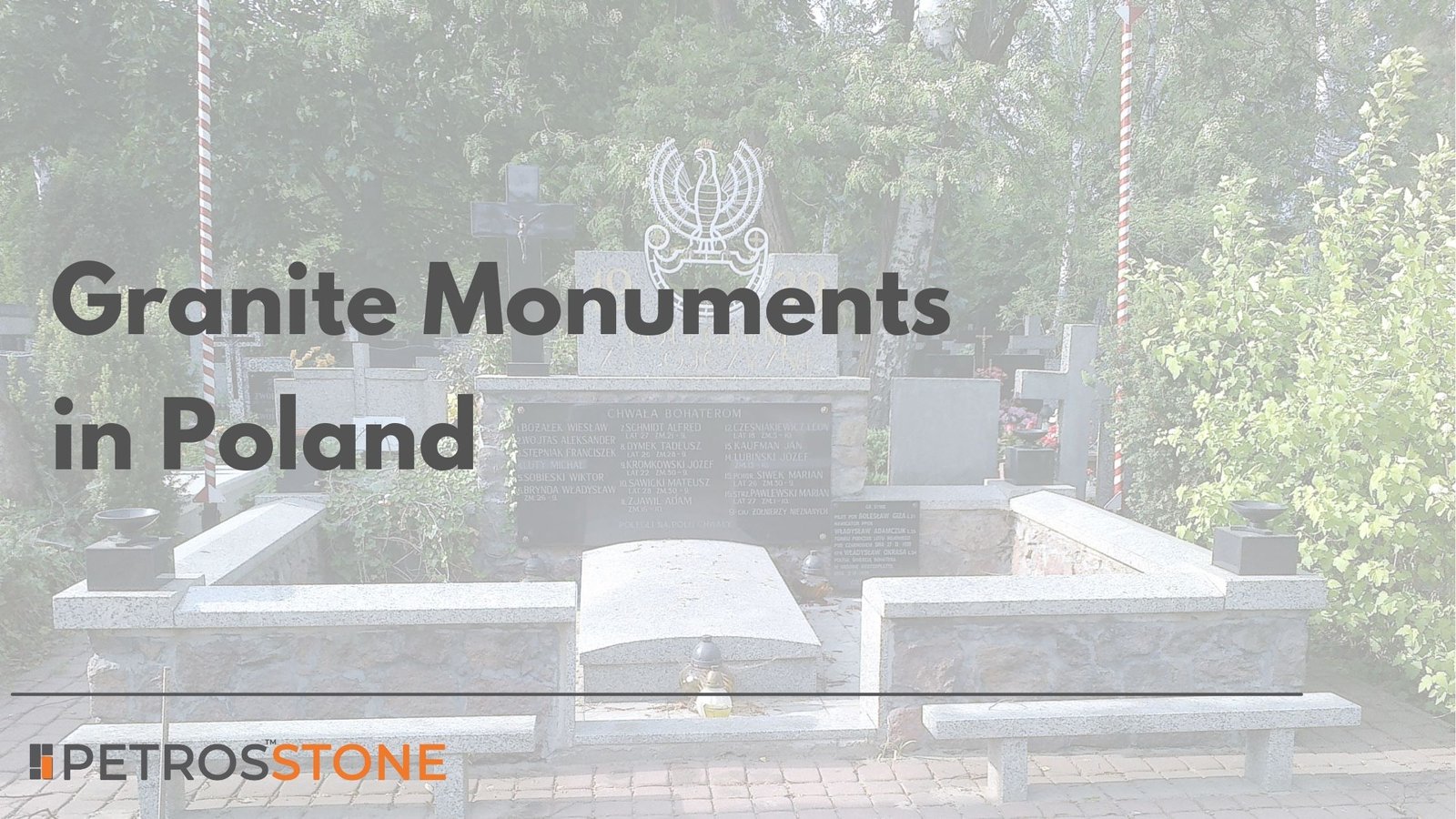
One of the most evident elements of Polish cemeteries and memorial sites is granite monuments. They are strong reminders of the past, admiration, and cultural identity. A walk through Warsaw, Kraków, or Gdańsk cemeteries is going to impress one with the great look of the polished granite tombs, headstones, and memorial crosses. They are not just stones: these monuments are stories, values, and history.
The use of granite monuments in Poland dates back many centuries. Its natural power, resistance to frost, and a variety of colors predetermine its popularity as a material in a country with long winters and lots of rain. Compared to other softer materials like marble or sandstone, granite is capable of withstanding generations before fading off its polish. To the Polish family, this permanence signifies the concept of memories that are everlasting.
Price Details of Polish Granite Monuments (Approx.)
| Granite Type | Average Price (PLN) | Average Price (EUR) |
| Absolute Black | 8,000 – 15,000 | €1,800 – €3,300 |
| Shanxi Black | 6,000 – 10,000 | €1,300 – €2,200 |
| G603 Grey | 3,000 – 6,000 | €650 – €1,300 |
| Steel Grey | 5,000 – 9,000 | €1,100 – €2,000 |
| Aurora Red | 10,000 – 18,000 | €2,200 – €4,000 |
| Bahama Blue | 12,000 – 20,000 | €2,600 – €4,400 |
| G664 Pink | 4,000 – 7,000 | €850 – €1,500 |
| India Red | 9,000 – 16,000 | €2,000 – €3,500 |
| Multicolor | 7,000 – 12,000 | €1,500 – €2,600 |
| Seawave White | 8,000 – 14,000 | €1,800 – €3,100 |
In this blog, we will discuss how granite monuments in Poland reflect deep cultural roots, the factors that families consider when choosing granite, the most popular stone types, regional preferences, industry structure, and prices. Lastly, we share practical advice to help families select the right monument.
The Role of Granite in Polish Memorial Culture
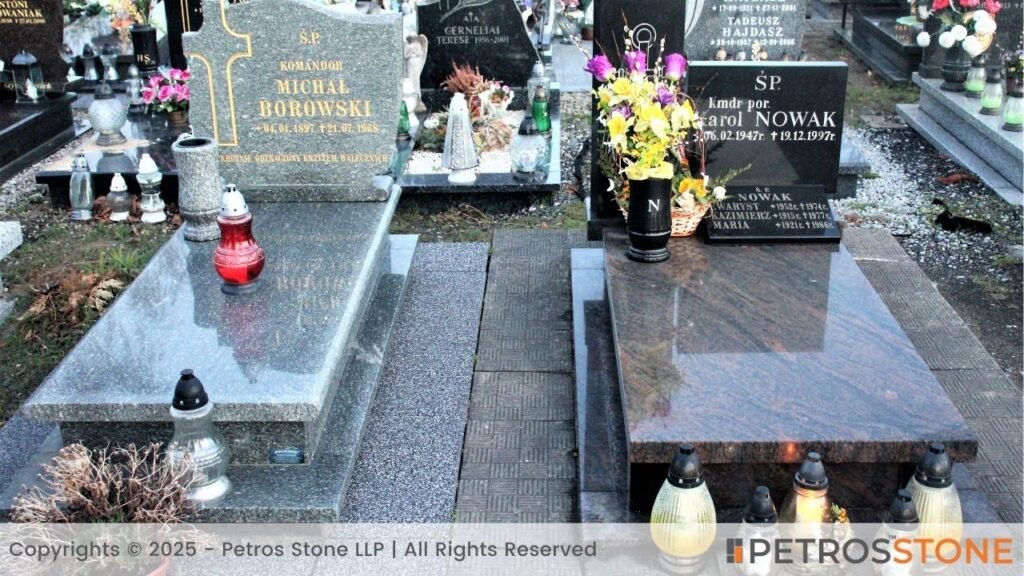
Polish culture cherishes memory. The strong tradition of remembrance was left behind by historical tragedies, including the partitions of Poland and World War II, as well as the communist rule. The country is covered with monuments of heroes, victims, and loved ones. Granite monuments in Poland are central to this tradition, combining symbolic and practical value.
The Role of Granite Monuments in Poland’s Memorial Culture
- Durability: Granite will resist the harsh climate of Poland. Marble may become dull or crack, whereas granite is solid.
- Symbolism: Granite is an eternal stone. Its hardness symbolizes power, stamina, and uninterrupted memory.
- Religious Connection: Catholics hold that graves are holy. Families are willing to invest in the best granite monuments to dignify their family members.
- Aesthetic Appeal: The graves have a solemn yet beautiful look because of polished granite, which forms a reflective surface.
- National Pride: Poland is an importer of granite in India, China, and Africa, but domestic quarries are also appreciated, particularly in Lower Silesia. Granite monuments in Poland, therefore, symbolize local imagination and a quality that is universal.
Common Uses of Granite in Poland:
- Multi-generational family graves.
- Personalized engravings and photographs on individual headstones.
- Memorials in honor of soldiers and resistance fighters.
- Cultural monuments for poets, scientists, and national figures.
Granite has been so embedded into the Polish memorial culture that it is hard to envision a cemetery without it.
Key Criteria for Selecting Granite for Monuments
When Polish families choose granite as the material for a monument, they balance emotions, traditions, and practical considerations.
| Criteria | Details | Why It Matters in Poland |
| Durability | Granite should resist cracking and weathering. Its compressive strength is typically 140–210 N/mm² and hardness 6–7 on Mohs scale. | Poland’s severe winters with freeze–thaw cycles can damage weaker stones. |
| Color | Options include black, grey, red, blue, and pink. Each has symbolic meaning (black = respect, red = love/sacrifice, blue = peace). | Families often choose colors that reflect Catholic traditions and personal emotions. |
| Polishability | Ability to achieve a mirror-like finish. High-quality granite accepts deep polishing. | Enhances candlelight reflection and makes inscriptions stand out. |
| Cost | Imported stones (e.g., India Red, Shanxi Black) cost more than local grey/pink granites. | Families balance prestige with affordability. |
| Symbolism | Color and texture carry spiritual meaning (e.g., red granite in Catholic memorials, white granite for purity). | Symbolic choice helps align with religious traditions. |
| Maintenance | Dark stones hide dirt; light stones show stains. Some granites may need sealing to reduce water absorption (<0.5%). | Practical for long-term care of monuments. |
| Porosity & Water Absorption | Granite typically has water absorption of 0.2–0.5%. Lower absorption = less frost damage. | Essential to resist Poland’s wet climate and prevent cracks. |
| Grain Size & Texture | Fine to medium grain provides a smoother finish; coarse grains may chip. | Affects polish quality and engraving clarity. |
| Freeze–Thaw Resistance | Granite must tolerate repeated freezing and thawing cycles without scaling. | Poland’s climate demands high resistance to avoid structural damage. |
| Density & Weight | Granite density is ~2.6–2.8 g/cm³. Higher density = more durable but heavier for transport. | Impacts logistics and cost of installation. |
| Scratch & Abrasion Resistance | Granite ranks 6–7 on Mohs hardness, resisting scratches from tools or cleaning. | Important for monuments in public cemeteries exposed to visitors. |
| Heat Resistance | Withstands up to ~250°C, but sudden temperature changes can stress the stone. | Useful where candles and lanterns are placed regularly. |
| Local vs. Imported Quarry Source | Local granites (like Strzegom Grey) are affordable; imports like Aurora Red add prestige. | Source affects cost, availability, and cultural perception. |
| Sustainability & Ethical Quarrying | Environmentally responsible quarrying and transport footprint. | Increasingly relevant for eco-conscious Polish families. |
| Engraving & Carving Quality | Fine-grained granites allow sharp lettering and detailed artwork. | Ensures inscriptions remain readable for decades. |
| Cemetery Regulations | Some cemeteries restrict monument size, style, or color. | Families must comply with local rules in Polish towns. |
The selection of granite is therefore not only a good practical choice but also a symbolic one.
Ten Popular Types of Granite Monuments in Poland
There are many types of granite used in Polish cemeteries. They also import some of them in Asia, Africa, and Scandinavia, and some of them in Europe. Each has unique qualities. Let’s examine them in detail.
Absolute Black Granite
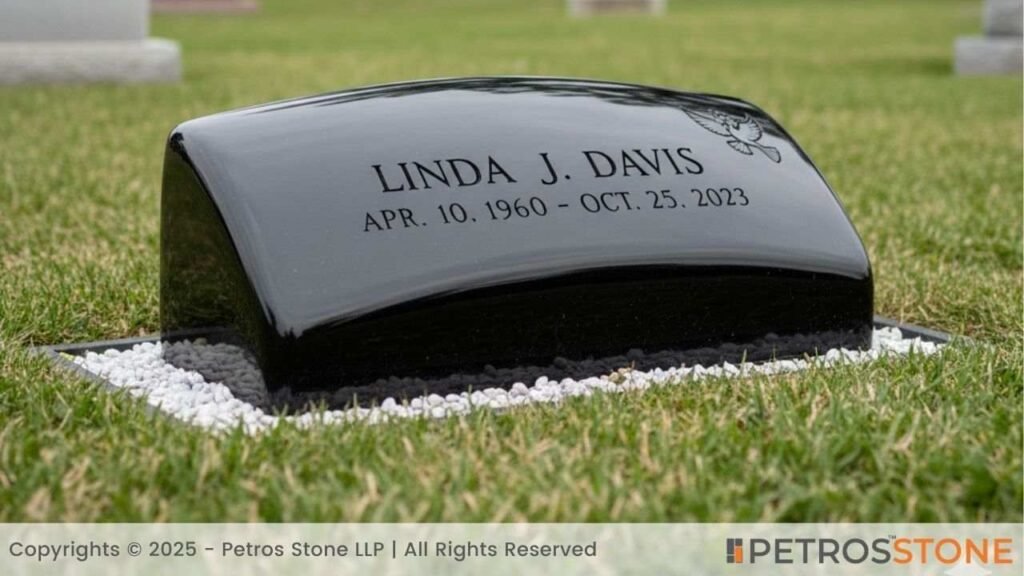
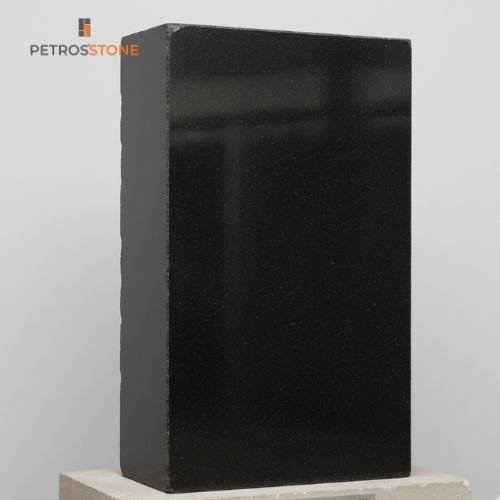
- Origin: India (Khammam, Warangal) and Zimbabwe.
- Color: Solid, deep black.
- Features: Very fine-grained, uniform, and highly polishable.
Absolute Black Granite is the monarch of style in Polish cemeteries. Its mirror finish gives it a brooding, ancient quality. Most of the families prefer it to the prestigious monuments because it reflects light from candles on All Saints Day.
Cultural Use in Poland:
- Popular in Warsaw and big cities, where families tend to take modern, smooth designs.
- Frequently used with full family tombs, engraved crosses, and gold lettering.
Pros & Cons
| Pros | Cons |
| Luxurious appearance | Expensive |
| Extremely durable | Requires careful handling |
| Works well with engravings | Shows fingerprints easily |
In Poland, Absolute Black is regarded as the “Mercedes” of granites.
Pink Granite
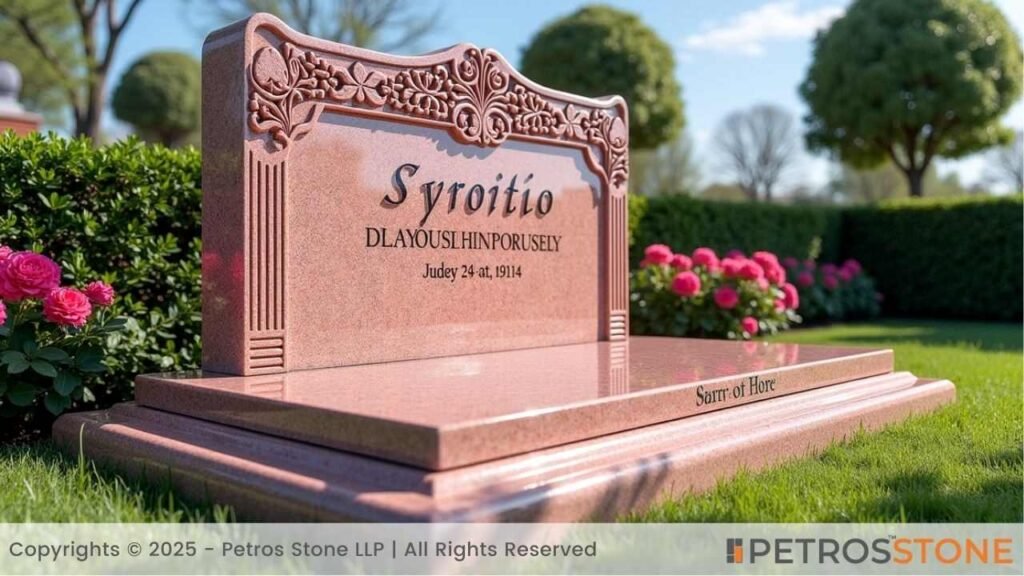
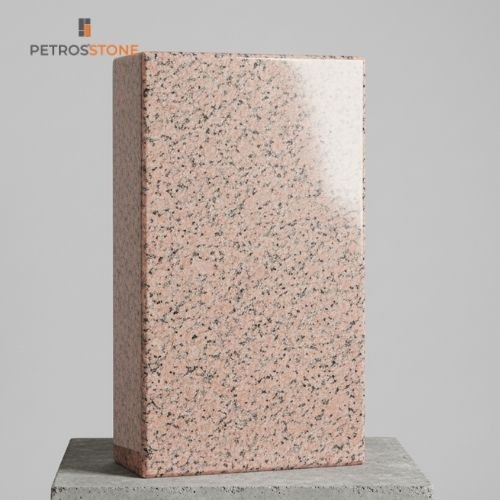
- Origin: Fujian Province, China.
- Color: Soft pink with grey and black grains.
- Features: Affordable and slightly less dense than black granite.
Pink Granite provides a warm and kind appearance, and that is the opposite of the seriousness of black granite. This is often selected by families wishing to have a gentler emotional coloring.
Cultural Use in Poland:
- More common in smaller towns.
- Commonly used on the graves of women to represent love and gentleness.
Pros & Cons
| Pros | Cons |
| Affordable option | Less durable than black |
| Warm, unique tone | May fade under sunlight |
| Symbolic of love | Not considered traditional |
Shanxi Black Granite
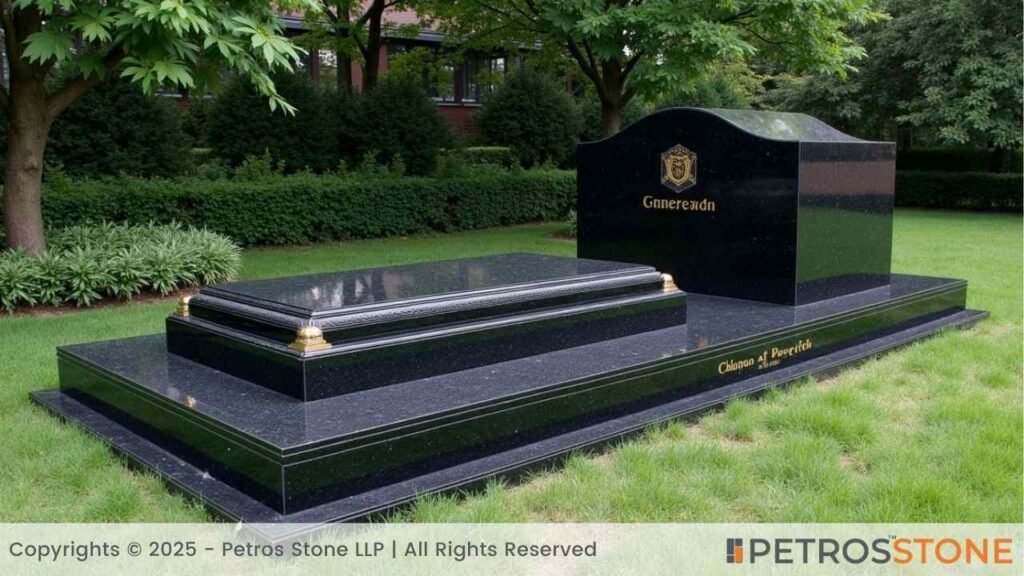
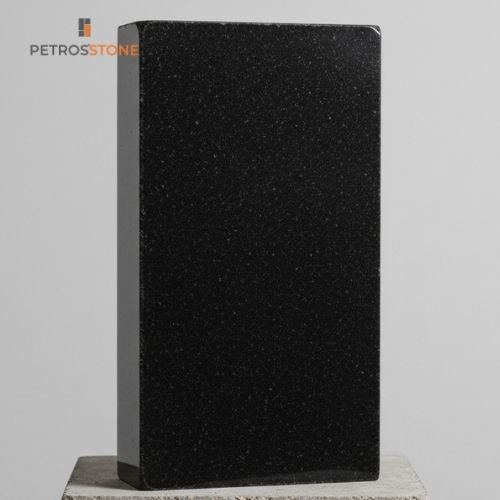
- Origin: Shanxi Province, China.
- Color: Jet black, though slightly lighter than Absolute Black.
- Features: Dense, uniform, and easy to polish.
Shanxi Black is the less expensive version of Absolute Black. It is almost identical but costs less, thus being popular with middle-class families.
Cultural Use in Poland:
- Chosen for single graves and smaller monuments.
- Other colors are used to provide a decorative contrast sometimes.
Pros & Cons
| Pros | Cons |
| Cheaper than Absolute Black | Color not as deep |
| Elegant appearance | Variable quality |
| Widely available | Imported – longer delivery time |
Bahama Blue Granite
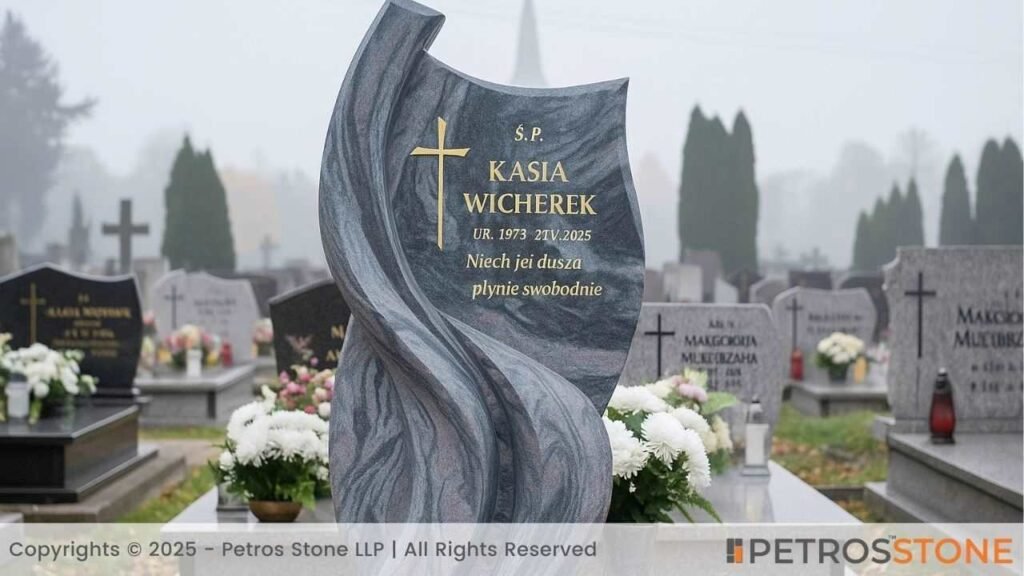
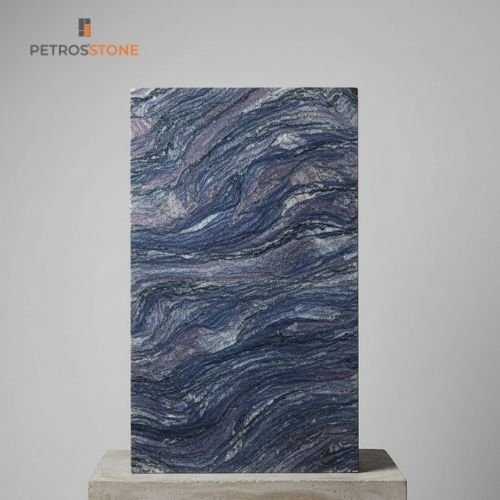
- Origin: India.
- Color: Swirling shades of blue, violet, and grey.
- Features: Eye-catching patterns, very artistic.
Bahama Blue is a modern twist to Polish cemeteries. Its rotating motion represents water and peace. Bahama Blue is usually chosen by families who do not want to have a conventional black or grey.
Cultural Use in Poland:
- Popular in Gdańsk and coastal regions, possibly because of association with the sea.
- Applied to modern curvy designs.
Pros & Cons
| Pros | Cons |
| Unique, modern look | Expensive |
| Strong polish | Not traditional |
| Rare – adds exclusivity | Harder to engrave clearly |
Aurora Red Granite
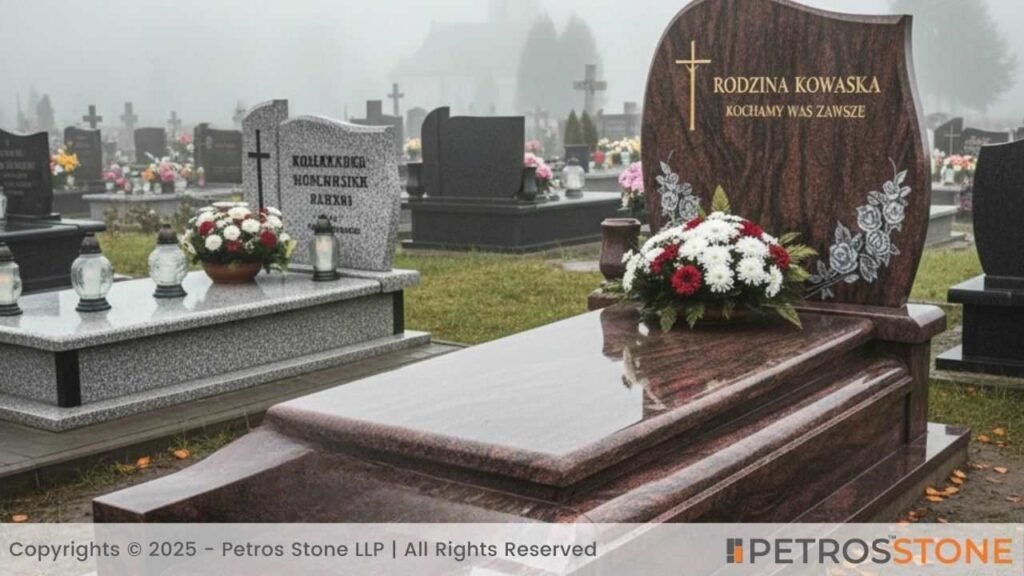
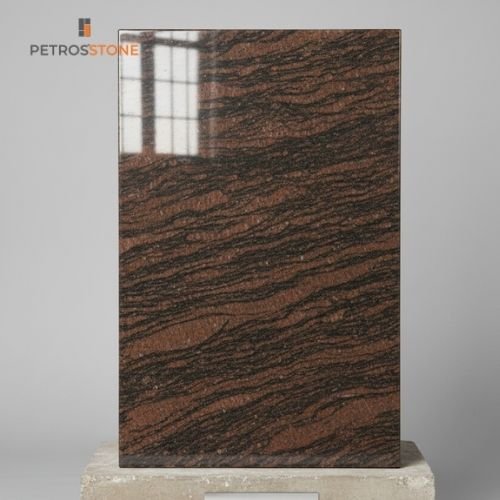
- Origin: Finland (Baltic area) and India.
- Color: Bright red with flowing black/grey veins.
- Features: Highly dramatic appearance.
Aurora Red Granite is loaded with symbolism in Poland- red is a color of love, blood, and sacrifice. It is often applied to military or patriotic monuments.
Cultural Use in Poland:
- Aurora Red is used in many war memorials in Poland.
- Red granite is a symbol of devotion and martyrdom in Catholic cemeteries.
Pros & Cons
| Pros | Cons |
| Bold statement | Too striking for some |
| Strong symbolism | Higher cost |
| Long-lasting polish | Not suitable for minimalist styles |
Steel Grey Granite
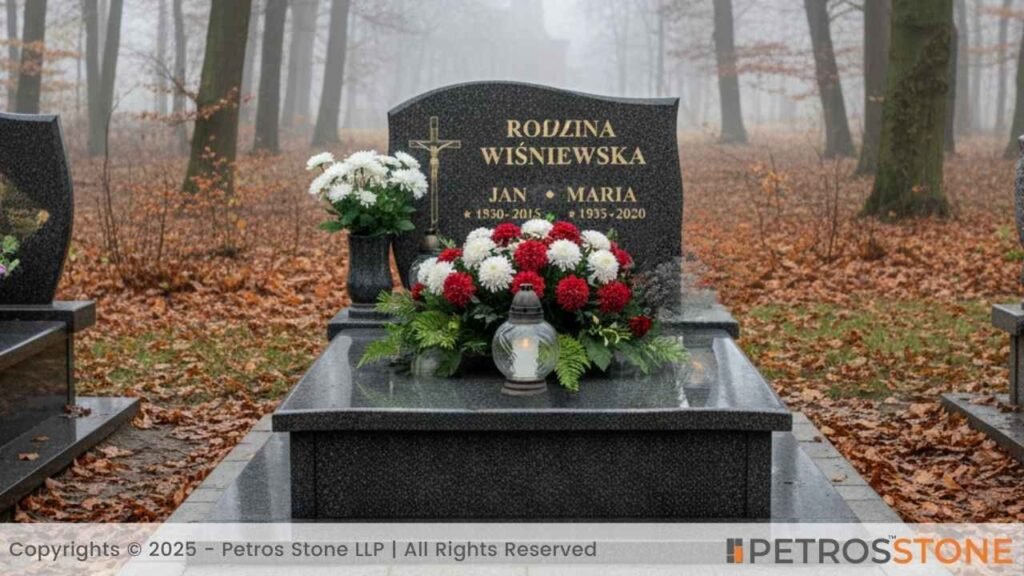
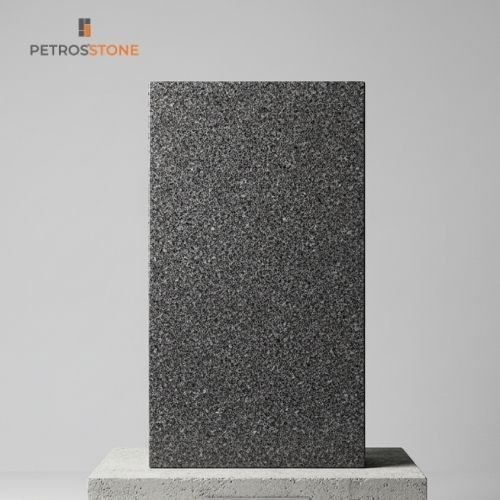
- Origin: India.
- Color: Dark grey with silver flecks.
- Features: Neutral, elegant, and durable.
Steel grey is a gray granite in between. It is not very attractive but is classy. Most families opt to use it as a compromise between tradition and cost.
Cultural Use in Poland:
- Usually found in urban and rural cemeteries.
- Good with family tombs where finances are tight.
Pros & Cons
| Pros | Cons |
| Affordable | Lacks uniqueness |
| Neutral look | Can seem dull |
| Easy to maintain | Common choice |
Light Grey Granite
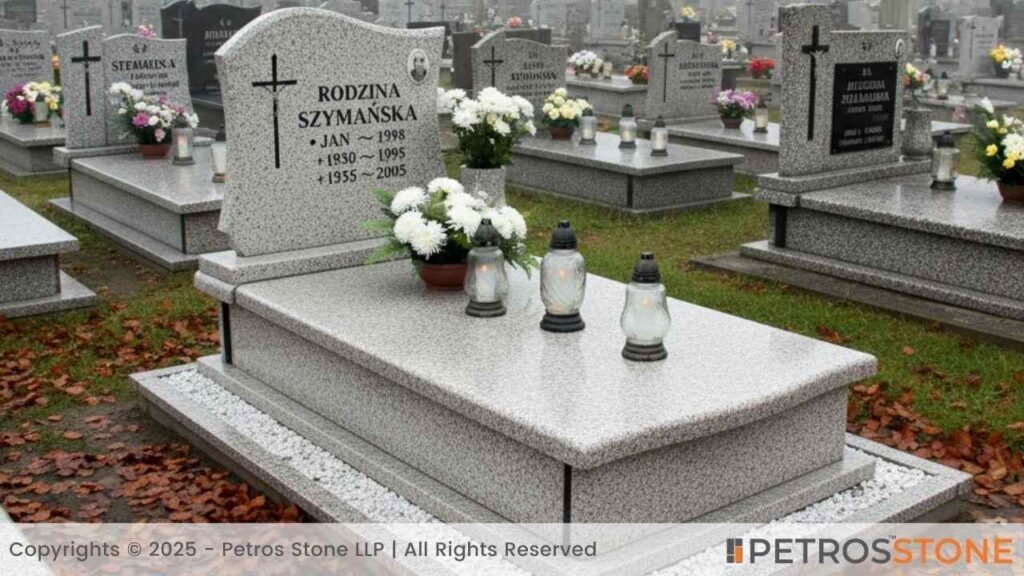
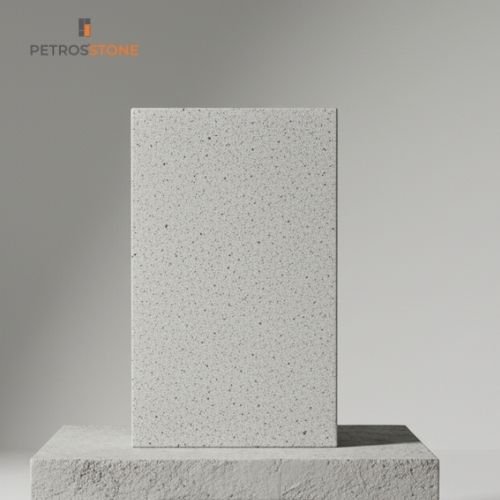
- Origin: China.
- Color: Soft light grey with black grains.
- Features: Very affordable and widely available.
G603 is the budget leader. It is straightforward, conventional, and applied in large cemetery projects.
Cultural Use in Poland:
- Popular in smaller towns and villages.
- Used when families prefer simplicity rather than luxury.
Pros & Cons
| Pros | Cons |
| Very cheap | Less durable in frost |
| Traditional look | Fades faster |
| Easy availability | Considered “basic” |
India Red Granite
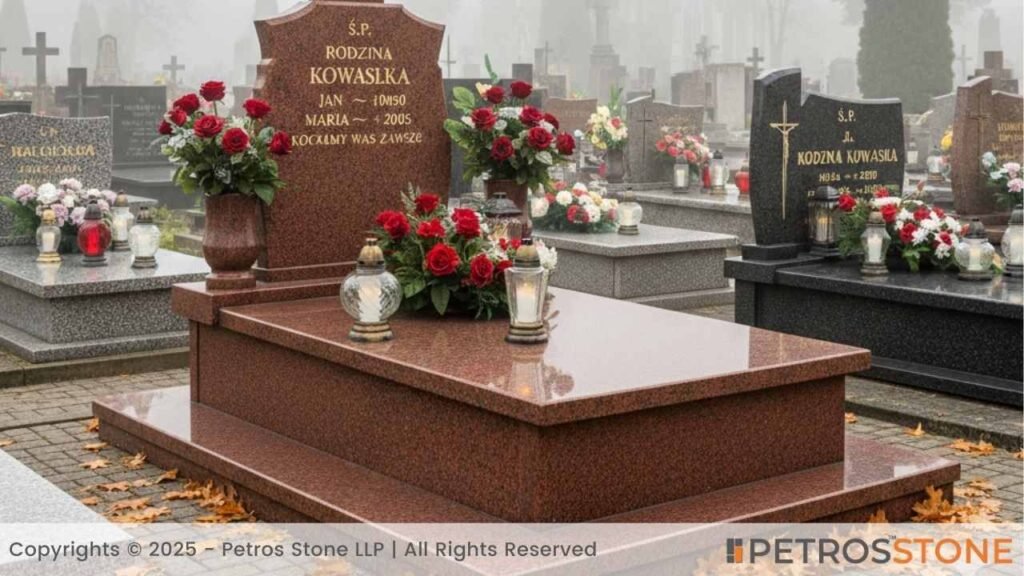
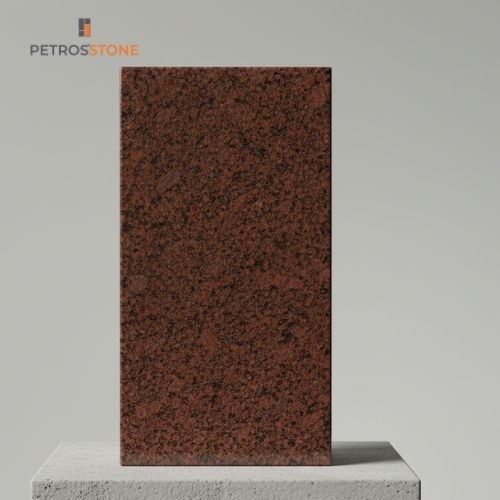
- Origin: India.
- Color: Deep, rich red with dark accents.
- Features: Dense, durable, and symbolic.
Catholic Poland prefers to use India Red as red is symbolized with love, sacrifice, and everlasting dedication. It is frequently used as a grave for parents or grandparents.
Cultural Use in Poland:
- Popular in southern Poland, particularly around Krakow.
- Used in the graves of priests and religious leaders.
Pros & Cons
| Pros | Cons |
| Strong symbolism | Pricey |
| Beautiful polish | Requires cleaning |
| Long-lasting | Not everyone likes bold colors |
Multicolor Granite (Combinations)
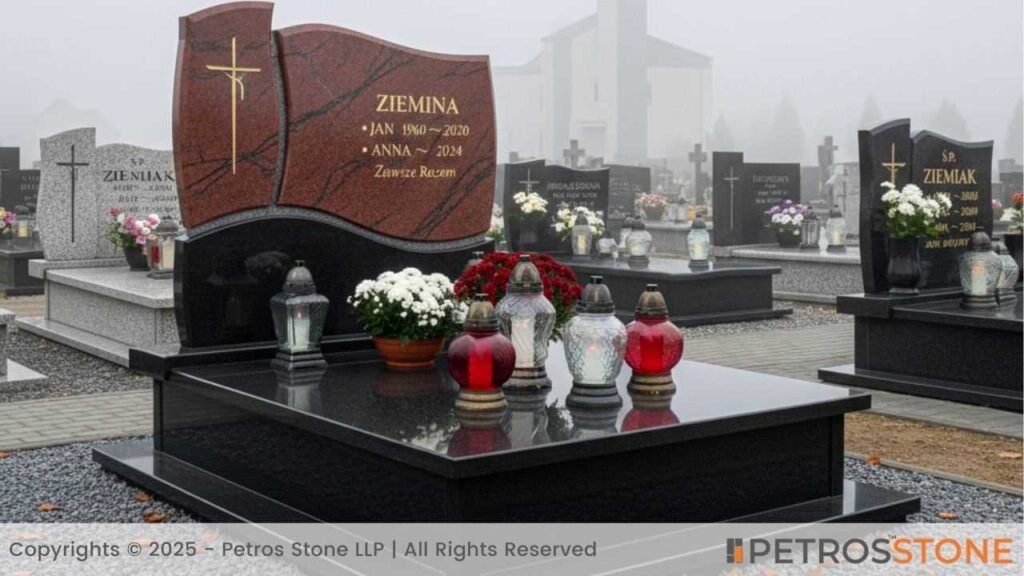
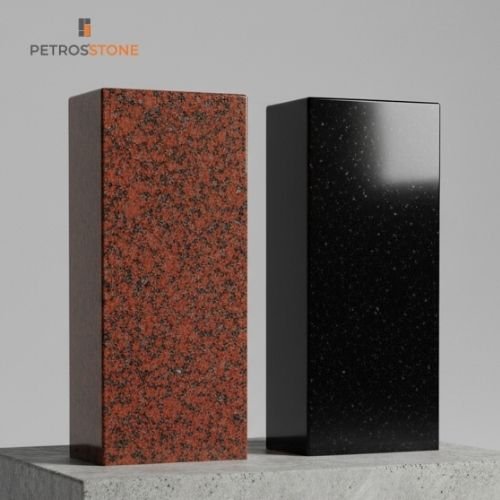
- Origin: Mix of China, Africa, and India.
- Color: Dual tones like black with pink, or red with grey.
- Features: Contrasting patterns for artistic designs.
Families occasionally desire unique monuments. Creativity is possible through multicolored granite combinations. An example is a red top and a black base.
Cultural Use in Poland:
- Seen in modern cemeteries.
- Gaining popularity among young people.
Pros & Cons
| Pros | Cons |
| Unique design | More expensive |
| Attractive contrast | Can look “too modern” |
| Symbolic combinations | Harder to maintain |
Seawave White Granite
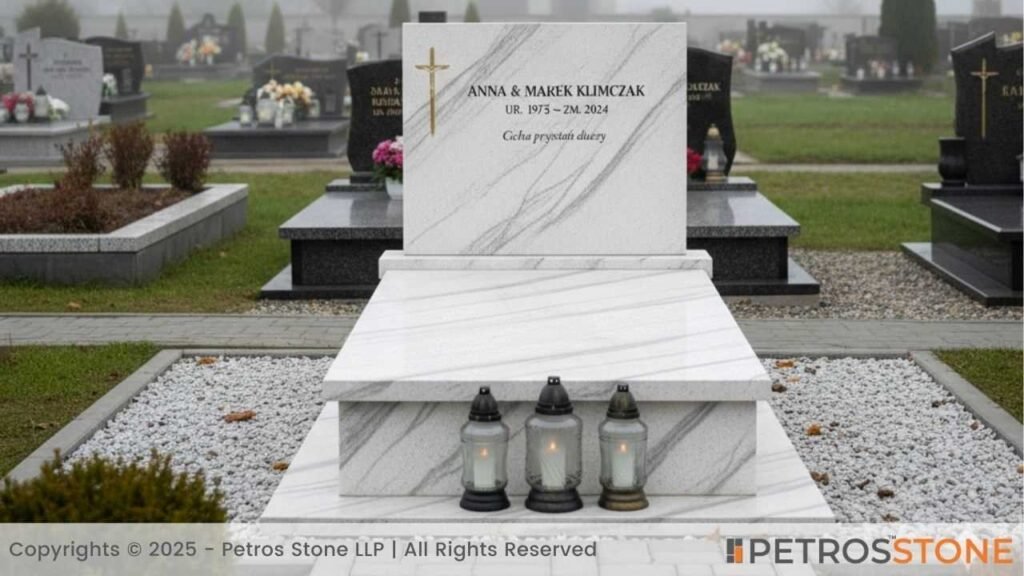
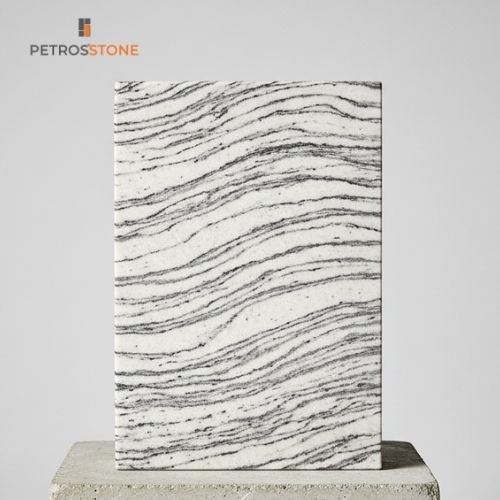
- Origin: China.
- Color: White with grey wave-like patterns.
- Features: Calm, minimalist, and rare in Poland.
Seawave White does not enjoy popularity in Poland but is finding its way in minimalist and modern graves.
Cultural Use in Poland:
- Often used by families who prefer something light and quiet.
- Seen more in newer cemeteries with modern layouts.
Pros & Cons
| Pros | Cons |
| Elegant and calm | Shows stains easily |
| Unique | Expensive |
| Matches modern styles | Rare in Polish tradition |
Regional Differences in Granite Preference
Granite options are not homogeneous in Poland.
| Region | Preferred Granite | Reason |
| Warsaw & Central Poland | Absolute Black, Shanxi Black | Modern, urban preferences. |
| Southern Poland (Kraków, Silesia) | India Red, Aurora Red | Strong Catholic symbolism of sacrifice. |
| Eastern Poland (Lublin, Białystok) | Light Grey, Steel Grey | Affordable and practical. |
| Northern Poland (Gdańsk, Szczecin) | Bahama Blue, Seawave White | Influence of the sea and modern tastes. |
| Rural areas | Pink, Grey granites | Affordable and traditional. |
Monument Styles and Granite Pairings
Classic Cross
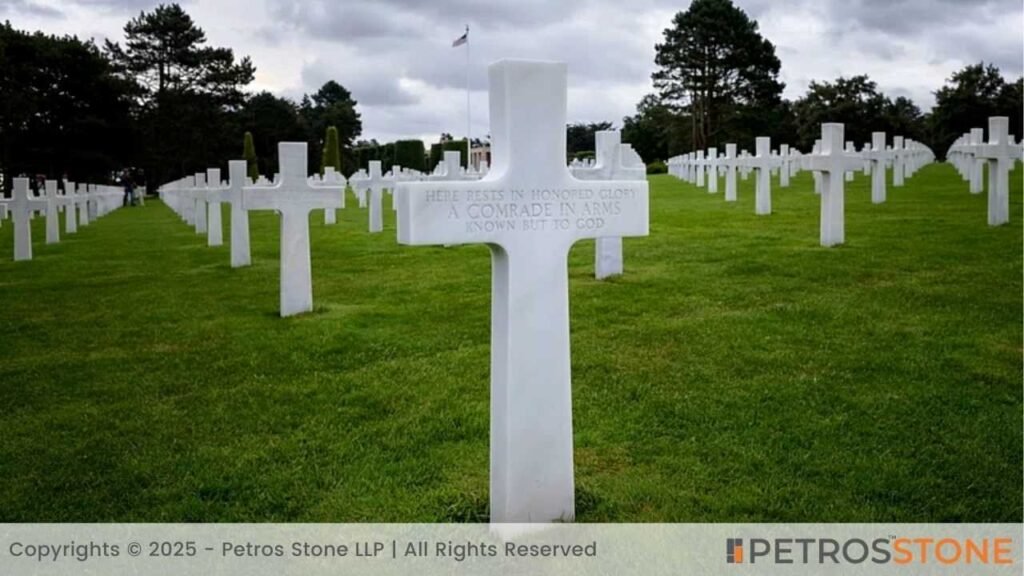
- Catholic style that is most prevalent in Polish cemeteries.
- Preferably constructed in Absolute Black or Steel Grey granite.
- Black granite → brings added sophistication and power.
- Grey granite → provides a less intense, more modest, more ancient look.
Modern Flat Slab
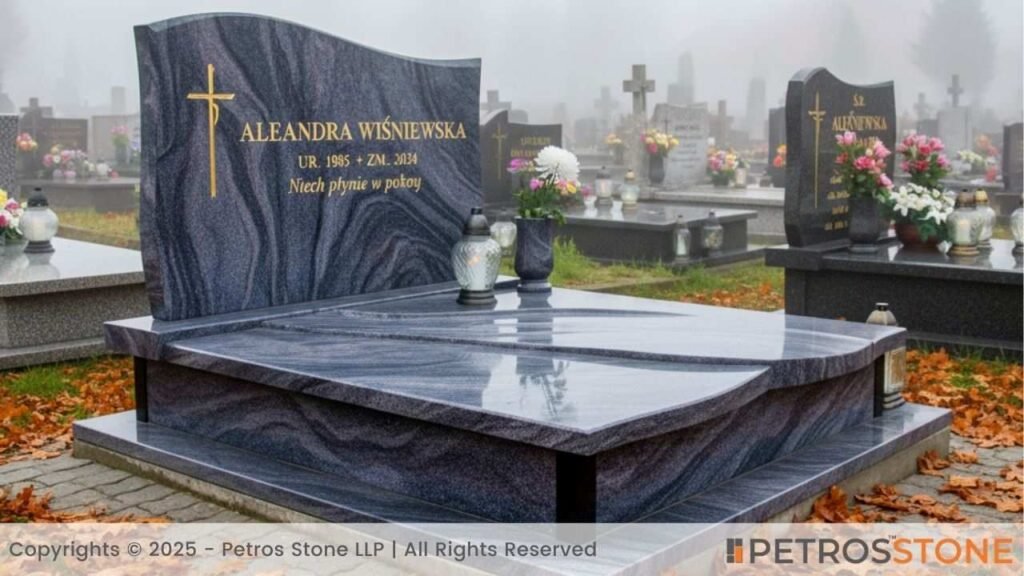
- Common in urban cemeteries where the family likes a modern design.
- Popular options Seawave White or Bahama Blue granite.
- White granite→ signifies peace and purity.
- Blue granite → brings peculiarity and artistry.
Family Tomb
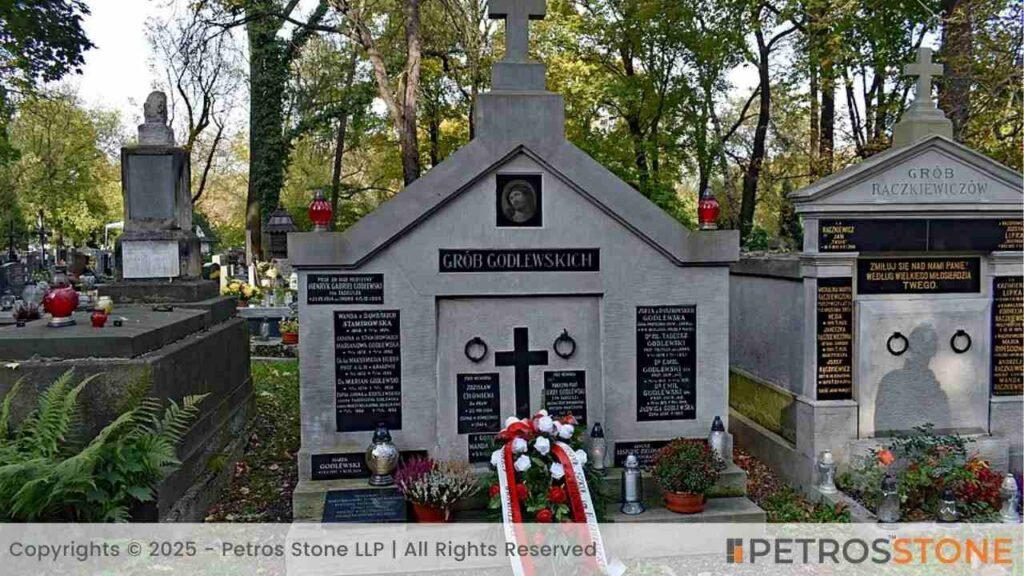
- A larger building to accommodate several generations.
- Popular options such as G603 Light Grey or G664 Pink granite are affordable.
- Grey granite → symbolizes conservatism and utility.
- Pink granite → brings in a warm and soft aesthetic.
Heroic/Military Monuments
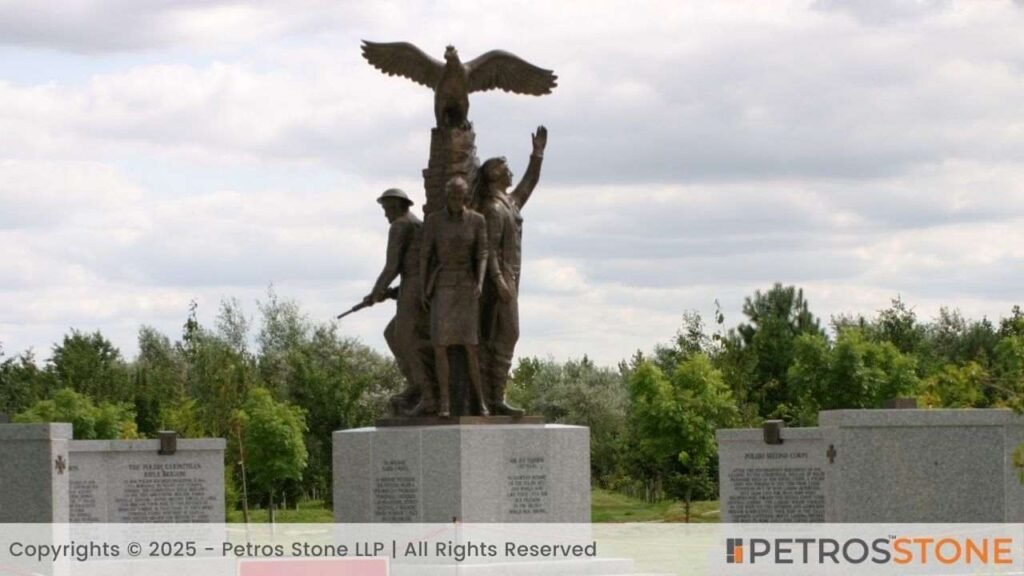
- Devoted to soldiers, martyrs, and national heroes.
- Typically constructed of granite, either Aurora Red or India Red.
- Red granite – represents blood, sacrifice, and patriotism.
- These monuments are strong and bold in color.
Minimalist Tablet
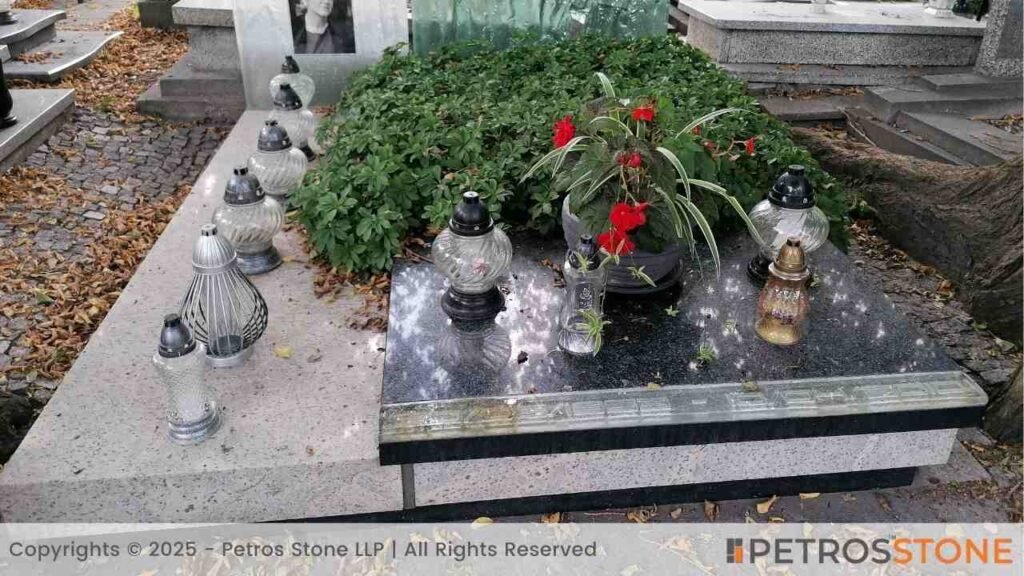
- Rectangular or square tablet.
- It is primarily composed of Shanghai Black granite.
- Slick, low-priced, and uncluttered.
- The black background is distinctive in engravings.
Table – Monument Styles and Granite Pairings
| Style | Granite Pairing | Why It Works |
| Classic Cross | Absolute Black, Steel Grey | Traditional and elegant. |
| Modern Flat Slab | Seawave White, Bahama Blue | Minimalist and artistic. |
| Family Tomb | G603, G664 | Affordable and simple. |
| Heroic/Military | Aurora Red, India Red | Symbolizes sacrifice. |
| Minimalist Tablet | Shanxi Black | Clean and budget-friendly. |
The Polish Granite Monument Industry Structure
- Local Quarries
- Poland is well endowed with granite, particularly in Lower Silesia.
- The most notorious granite centre of the country is Strzegom, which is associated with the perennial light-grey granite.
- Monuments, pavements, and public memorials are frequently made of locally quarried stone.
- Importers
- A substantial portion of granite is imported from India, China, and Africa.
- Indian granites such as Absolute Black and India Red are very desirable.
- Chinese granites are imported as cheap alternatives.
- African granites (such as Angola Black) introduce quality selections to the market.
- Workshops
- There are numerous stone-cutting enterprises, small, family-owned.
- They are experts in monument cutting, polishing, and customization.
- The quality of craftsmanship is different, but sometimes the reputation of these workshops is determined.
- Retailers
- Monuments are finished and sold out of local showrooms or funeral homes.
- Retailers tend to showcase standard designs, but they can also take custom orders.
Price Details Granite Monuments in Poland (Approx.)
| Granite Type | Average Price (PLN) | Average Price (EUR) |
| Absolute Black | 8,000 – 15,000 | €1,800 – €3,300 |
| Shanxi Black | 6,000 – 10,000 | €1,300 – €2,200 |
| G603 Grey | 3,000 – 6,000 | €650 – €1,300 |
| Steel Grey | 5,000 – 9,000 | €1,100 – €2,000 |
| Aurora Red | 10,000 – 18,000 | €2,200 – €4,000 |
| Bahama Blue | 12,000 – 20,000 | €2,600 – €4,400 |
| G664 Pink | 4,000 – 7,000 | €850 – €1,500 |
| India Red | 9,000 – 16,000 | €2,000 – €3,500 |
| Multicolor | 7,000 – 12,000 | €1,500 – €2,600 |
| Seawave White | 8,000 – 14,000 | €1,800 – €3,100 |
Prices depend on the complexity of the design, engraving, and cost of imports.
How to Choose the Right Granite Monument in Poland
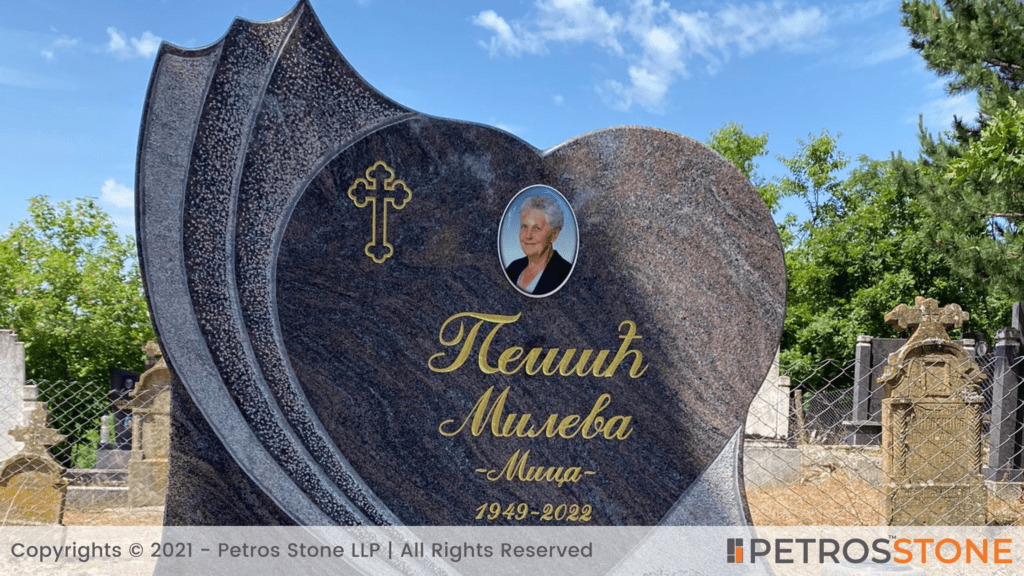
Step 1: Set a Budget
Granite may cost between 3,000 PLN (€650) and over 20,000 PLN (€4,400).
Step 2: Decide the Monument Style
Would you prefer a traditional cross, a slab, or a family tomb?
Step 3: Choose the Granite Type
- Black for elegance.
- Red for devotion.
- Blue for modern peace.
- Grey for tradition.
Step 4: Check Cemetery Rules
Certain cemeteries limit the size of monuments or their colors.
Step 5: Select a Craftsman
The quality of polishing and engraving is more important than the price of granite.
Step 6: Think Long-Term Maintenance
- Black granite: easy to clean.
- White granite: shows stains.
- Grey granite: a practical choice.
Step 7: Add Personal Touches
The monument is personalized with engravings, photographs, or bronze decorations.
Summary
Granite monuments in Poland are not just stone markers; they are a representation of memory, tradition, and love. There is a meaning behind each type of granite, with the high-end Absolute Black, the symbolic Aurora Red, and so on. The selection is determined by regional preferences, cultural traditions, and personal budgets.
Granite monuments will remain at the heart of the Polish tradition of preserving the memory of ancestors, heroes, and beloved ones due to the rich memorial culture of the country. The selection of the appropriate granite is not only a financial choice but a very emotional process to make sure that the memory of the people who are loved can be remembered throughout generations.
Key Takeaways
- Granite monuments are deeply rooted in Polish culture, symbolizing durability, faith, and remembrance.
- Regional preferences vary—Absolute Black is popular in Warsaw, while India Red and Aurora Red are favored in southern Poland for their religious symbolism.
- Prices range from 3,000 to 20,000 PLN (€650–€4,400), depending on granite type, design complexity, and import status.
- Key selection criteria include frost resistance, polishability, symbolism, engraving clarity, and cemetery regulations.
- Choosing a granite monument in Poland is both a practical and emotional decision that ensures lasting tribute across generations.
Feel free to get in touch for a free consultation, quote, and get a detailed understanding from our experts here at Petros®. Visit https://petrosstone.com/ or call +91-8446360361 and WhatsApp

Hello!
I’m Dr Mridali, a content writer with a background in dentistry and a passion for turning complex topics into clear, engaging stories. From healthcare to architecture, I create blogs that inform, educate, and connect with readers. With every piece, I aim to blend accuracy with creativity to make information truly valuable.
Brown Granite
White Galaxy Granite
Blue Bahia Granite
Silver Cloud Granite
Black Pearl Granite
Dallas White Granite

